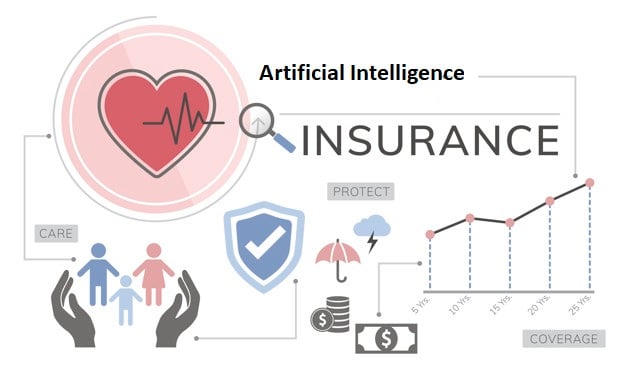- Developers
- Developer Blog
- AI Software Development
- How to Build an AI Platform like Pypestream for the Insurance Industry?

profile

By Faiza Khalid
Verified Expert
5 years of experience
Faiza is a CIS engineer with a keen interest in software development, AI research, and technology writing.
Are you interested in building an AI platform for the insurance industry? In this article, we provide the answers on how to do just that.
AI in insurance is becoming increasingly popular thanks to platforms like Pypestream. According to a recent research report, Artificial Intelligence (AI) in the insurance industry market is expected to reach a 6.92 billion USD valuation by 2028.
In this article, we focus on creating a conversational AI for the insurance industry. We start by examining how conversational AI platforms like Pypestream help insurance agents and then move on to how you can build such an AI platform.
Pypestream – A Conversational AI platform:
Pypestream provides businesses with a customer engagement solution. It helps them to build customer relationships via smart, instant messaging. The smart system uses AI to undertake conversations with customers, in many cases resolving their issues effectively without the need for a human operator.
Unlike rule-based chatbots that follow a predefined workflow, conversational AI platforms make use of the latest AI natural language processing techniques like semantic analysis to understand what a user is looking for by examining language patterns.
This engaging chatbot platform helps insurers with the marketing and distribution of insurance, claims management, such as claims processing and fraudulent claims detection, insurance policy administration, and financial services like billings and payments, etc. Research has shown that AI helps streamline claim processing by 22%.
The following are some of the features the Pypestream AI platform provides to the insurance industry. These would give you an idea of what you need to develop in your AI solution.
What to Build? – Pypestream Example:
User Interface:
Pypestream comes with an intuitive user interface. The interactive UI is enriched with multiple widgets and customization options for a personalized and effective customer experience.
It provides features such as a shopping cart, password management, file upload, document signatures, secure checkout, etc.
AI and Automation:
Pypestream uses the latest in machine learning techniques to power multiple features and tools. It uses NLP to understand human conversations and is able to understand mood, tone, emojis, etc. This helps the AI system to effectively understand users’ problems, much like a human could.
Moreover, it can understand multiple languages, thereby making your customer support accessible to a diverse range of customers. Conversational AI platforms would reach a market value of USD 36.62 billion by the year 2030. The insurance industry is a big segment of the AI chatbot market.

Get a complimentary discovery call and a free ballpark estimate for your project
Trusted by 100x of startups and companies like
Pypestream provides an automation engine to help developers connect their backend systems seamlessly. It also provides real-time analytics to provide insights into customers’ interactions with the insurance business platform.
Live Customer Support:
Agent Pro feature of Pypestream enables live communication with numerous customers at once. Multiple channels display all the relevant customer information. Agents can quickly resolve customer problems that the automation system is unable to solve.
Conversational Ads:
These ads engage customers in real-time conversations. The personalized experience has been proven to boost sales.
Customer Data Security:
Pypestream solution is compliant with industry-standard security protocols to ensure user data protection across all channels.
How to Build an Insurance AI Platform?
You would go through the following steps to build an AI platform like Pypestream:
Plan your Software Specifications:
Understand and identify what process you want to innovate using AI. At this point, you also need to consider your user market expectations.
Next, decide on the specification you want to build, outline a hierarchy of chatbot functionalities, decide your AI infrastructure requirements, and identify the training and resource data repositories your AI would use, i.e., past FAQs, policy data, operation files, product documents, etc.
Build Software Development Team:
Your development team should consist of the following roles:
- AI engineers and data scientists;
- UI designer;
- Back-end developers;
- Application Tester;
- Project Manager.
Set up Development Infrastructure:
To build an AI platform, you need high-performance computing resources, storage capacity that scales with your application, a seamless high-bandwidth network, etc.
The cost-effective solution to meet the AI infrastructure requirements is to use a cloud-based solution.
Your technical team should be skilled in using cloud technology to build efficient end-to-end integrated systems, manage cloud storage, develop easily scalable solutions, etc.
Pypestream uses AWS as an Infrastructure-as-a-service (IaaS) to host their two private clouds. One manages conversational AI applications that users interact with, and the second virtual cloud hosts administration systems for monitoring and backup purposes.
Your AI engineers should be experts to help you adopt the most suitable cloud computing strategy to build a conversational AI platform.
The top cloud-based platforms that could assist you immensely in AI development include Microsoft Azure AI, Google Cloud AI, Amazon AI Services, etc. These platforms enable AI developers to develop and deploy advanced ML models with flexibility and scalability.
Moreover, cloud-hosted AI infrastructure helps software developers to focus on application development as the backend infrastructure is managed by the cloud service provider.
Select your Software Development Methodology:
You need a software development methodology to structure and plan your development procedures. The right development methodology would help your project managers to use your technical resources efficiently and ensure the timely delivery of the software application.
We advise you to adopt an agile methodology for AI platform development. Agile methodology breaks down the whole software development procedure into sprints. Tests are conducted at the end of each iteration, and client-side feedback is collected. This helps software developers to continuously improve the product in an iterative manner.
There are multiple frameworks to implement the agile methodology, like Scrum and Kanban. Scrum is widely adopted by software development teams as it is easy to implement and yields high-performance results from the team.
Read more about implementing the agile methodology using the Scrum framework in our blog here.
Design Application UI and Front-end Layout:
An application’s user interface and the overall user experience play a huge role in attracting customers and building loyal customer relationships.
Make sure your developers are skilled in the latest UX/UI techniques used to build interactive UIs. They should know about design techniques like wireframing, usability testing, visual designing, etc.
Your developers should consult the following design guidelines such as to build an interactive and seamless user experience:
- User Interface Guidelines for designing a web application;
- Material Design Guidelines for designing an Android application;
- Human Interface Guidelines for designing an iOS application.
Develop a Minimum Viable Product:
An MVP or minimum viable product contains your software’s essential features. MVP helps business growth in multiple ways. In regards to AI technologies, an MVP allows you to put your AI technology to work more quickly and to dramatically boost the training data that your AI has access to.
Hire expert developers for your next project
1,200 top developers
us since 2016
- You would be able to reach the user market in less time.
- You would be able to market your core software idea on a limited budget.
- You would be able to collect users’ responses to your AI platform quickly. This would help you improve and enhance your AI product according to user expectations right from the start.
To develop an MVP for an AI platform, you need specialized technical skills to implement AI models and use development tools efficiently. We discuss these in detail next.
Knowledge of Data Processing and Handling:
Data plays a huge role in building effective AI platforms. Your AI developers should be experts in data science and in big data handling techniques like ensemble analysis and high-dimensional analysis.
Moreover, they should be familiar with database management and analysis systems like Apache Storm, Cassandra, Hadoop, etc.
Knowledge of Supervised and Unsupervised Machine Learning:
Your software developers should have sound knowledge of supervised and unsupervised machine learning algorithms.
Supervised algorithms operate with a labeled dataset where each input data point is matched with its output. By reading a huge labeled dataset, the AI model learns how input is connected to the output value.
Unsupervised learning takes a more association-building approach. It reads a lot of unlabeled data and understands unstructured data trends by building a relationship between different data points. Unsupervised machine learning algorithms help produce a more human-like experience where a model learns from new information and past experiences without human intervention.
Some common supervised and unsupervised ML algorithms your AI developers should know how to implement are linear regression, support vector machines, random forest, k-means clustering, etc.
Knowledge of Neural Networks:
Your AI software developers should be knowledgeable about the latest neural network techniques. They should be experts in creating and training neural networks like convolution neural networks and in how long short-term memory is used when building efficient ML models.
For natural language processing applications like a conversational chatbots, LSTM neural networks are usually used as they help with the processing of serial data (text and voice).
Your AI development team should also be experts in deep learning implementation. A deep neural network is the latest advancement in ML neural networks. They can handle big data thanks to their ability to perform complex computations but require more processing power.
Deep neural networks are at the heart of all the latest AI technologies like Amazon’s Alexa, Baidu’s Deep Speech, and Google Translate.
AI Development Frameworks:
Your developers should be able to use AI code-based frameworks like Google Dialogflow to develop NLP engines from scratch. This helps build a custom conversational UI for your software applications where customers could communicate via text and audio.
Dialogflow offers features like end-to-end management for processes like CI/CD and analytics using advanced AI-based NLU models to better understand the context of a conversation, etc. Moreover, it supports 30+ languages.
AI Software Tools and Libraries:
Your AI engineers should be experts in prominent AI software tools like TensorFlow, Microsoft Cognitive Toolkit, Core ML, etc.
Core ML is a machine learning platform used to build AI solutions for Apple products like iOS, tvOS, etc. It is built on Swift programming language for easy app integrations. It efficiently supports the usage of pre-trained convolutional neural networks on Apple products.
Microsoft CNTK platform enables developers to build and combine multiple neural networks, including recurrent neural networks, feed-forward networks, and convolution neural networks. It works with multiple programming languages.
Programming Languages:
Your software development team should be proficient in programming languages that are commonly used for building ML models. On top is Python. An interpreted object-oriented programming language that is easy to read and use.
It is the preferred language of AI developers for data collection, visualization, modeling, and analysis. It has a broad ecosystem of frameworks and libraries for AI development.
Some common libraries your developers should know about include TensorFlow, Scikit-Learn, PyTorch, Keras, etc.
Python is often considered slower as it is dynamically compiled at runtime. It also consumes a lot of memory which is often an issue while implementing deep learning techniques. C++ is a good alternative with higher performance speeds and lower memory consumption.
Popular ML and deep learning frameworks like TensorFlow and Caffe are built using C++. However, it requires more effort to learn and use C++ for building AI models. It also has low security.
Java is another option in AI programming languages. It provides high security and features of multithreading and runtime code modification.
Security Compliance:
Compliance with set industry standards is essential when developing an application. Your software developers should ensure that your AI solution is compliant with security protocols and government regulations.
Some of the cybersecurity and compliance standards for a conversational AI platform include HIPAA for protecting patients’ healthcare information, GDPR data protection and privacy law in the European Union and European Economic Areas, WCAG2 for web content accessibility, etc.
Read more on how to build an AI SaaS product here on our blog.
Software Testing:
After development, the next stage is to test your AI MVP for bugs and errors.
Hire expert developers for your next project
In order to deliver bug-free software to the user market that meets all your set functional requirements, your development team should conduct thorough unit testing, integration testing, security testing, penetration testing, etc.
They should use tools like IBM Rational Functional Tester for testing app functionalities and Apache JMeter for integration and API testing.
Read more on how to prevent software product failure in our blog article here.
Software Deployment:
After conducting a thorough QA and ensuring that the AI software is industry-standard compliant and meets all set requirements, your software product is ready for release.
After deployment, you need to collect customer feedback. You could conduct surveys or encourage users to leave an app store review in the case of a mobile app. You should make use of social media to closely engage with your customers.
Some tools that could help you in gauging customer feedback are Hotjar, Userbrain, and UserReport. Companies, including Spotify, Shopify, Adobe, and Toyota are using such software to efficiently collect user feedback via survey forms and feedback widgets.
Improve your MVP:
After collecting user feedback, you have all the data you need to enhance your MVP to ensure your users remain interested in your AI product.
At this stage, apply data analytics to turn qualitative data into actionable insights. You should use tools like Qualtrics, Birdeye, and Thematics to analyze your customer data.
Repeat your product development iteration based on your market data analysis – Improve and add features, test, deploy, and collect user responses again.
Partner with Expert AI Developers
All the technical expertise and related domain knowledge discussed above highlight the fact that building a market-competitive customized AI platform requires a team of highly skilled AI engineers, data scientists, and software designers and developers.
At this point, you must be accessing your in-house team’s skills and your company’s available technical resources. If you don’t have the required skills or experience in your software development team, there are a few options you could utilize to build a competent development team.
It is very difficult to find all the required technical expertise in the local pool of talent available in your specific region. Therefore, partnering with remote developers is the most suitable course of action.
The first option that comes to mind is freelance developers. The freelance marketplace offers a huge variety of talent, however, the responsibility of assessment and management of freelance programmers still lies with you.
Moreover, freelancers are working on multiple projects at the same time. As such, there is a big chance of a freelance developer not giving one hundred percent to your AI project.
Given the drawbacks of finding the best talent in a sea of freelance programmers, we advise you to outsource software developers from a hybrid development company.
Outsourcing software developers to enhance your current in-house software development team is becoming an increasingly popular trend. It gives you, as a project manager or product owner, the flexibility to scale your technical resources as the project requires it.
Even if you do not have an in-house development team, you could outsource a small team, say a designer and two developers, and start your project. You can further add resources like app testers at a later stage, etc.
Partnering with an expert software development company would save you from all the pitfalls that come with hiring a freelance software developer.
Software development companies offer access to their full-time software developers, each skilled in a particular development niche. Moreover, they come with technical managers who are experienced in deploying similar software solutions.
Technical managers not only help you manage your outsourced developers but are also experienced so they can assist you in adopting the best possible software development strategy and even in managing your own in-house team of developers.
Why not take a moment to tell us a few details about your project? One of our technical managers could get in contact to assist you with any questions you might have and to help you find the right AI specialists and developers to build your next-level AI software solution.
Top FAQs on AI in Insurance
The latest and emerging technologies like telematics, IoT-based smart wearables, robotic automation, and blockchain enable AI models to gather real-world data and perform real-time operations efficiently and securely for insurance providers.
Chatbots are programmed to use AI and hold conversations with a predefined set of replies. They have limited capability of understanding communication intent and context. Conversational AI leverages advanced NLP (natural language processing) and NLU to interpret user messages and respond appropriately.
Insurance executives can bring remarkable innovations to their businesses by using AI for operational automation like an underwriting process, claims process, predictive risk assessment using risk management data collected while assessing risk cases, fraud detection such as non-health insurance fraud, sales, marketing, regulatory policy decision-making, etc.
Some top startups investing in AI auto insurance anticipating further technological development are:
Ant Financial: A Chinese company offering digital services from social media networking to banking. It connects user data from interconnected services to insurance carriers for building user risk profiles.
Lemonade: A startup investing in AI chatbots and big data analytics.
Fukuko Mutual Life: A business using AI-based IBM Watson for claim management.

Alexey Semeney
Founder of DevTeam.Space
Hire Alexey and His Team To Build a Great Product
Alexey is the founder of DevTeam.Space. He is award nominee among TOP 26 mentors of FI's 'Global Startup Mentor Awards'.
Alexey is Expert Startup Review Panel member and advices the oldest angel investment group in Silicon Valley on products investment deals.


